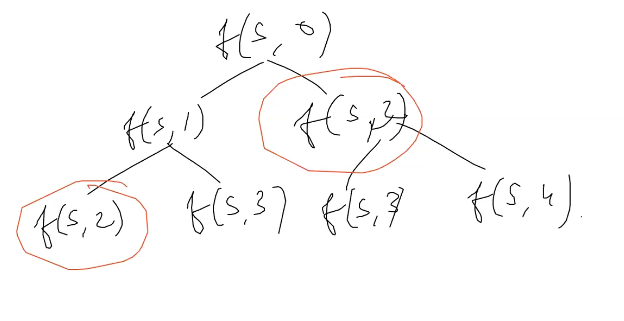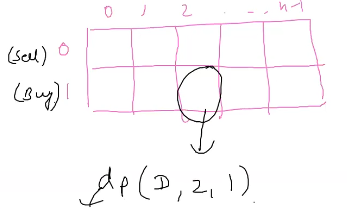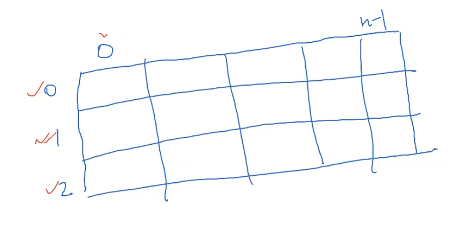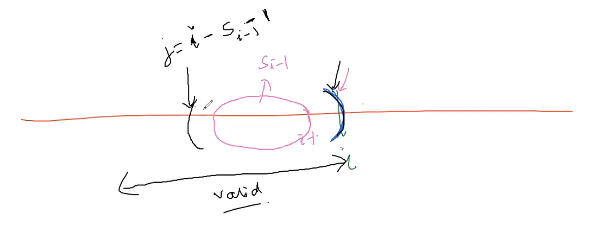DP 2
1D DP
Decode Ways :
Basically we see that the problem is a counting problem and we don’t want to enumerate.
Criteria for divide and conquer : lets find a criteria such that it makes solution mutually exclusive and exhaustive.
s1: set of all words made by considering only 1st character
s2: set of all words made by considering first 2 characters
Now lets try to connect to original subproblem.
Suffix Array :
Lets try to do the mathematical representation..
How many variables we require for suffix tree. => only one for starting index.
P <- f(S,0)
P1 <- f(S,1)
P2 <- f(S,2)
Recurrence : f(s,0) = f(s,1) + f(s,2);
f(s,1) : always counted because say 1034 we get 034 so its not valid split ( given ) we return 0
f(s,2) : not always counted if prefix > 26 even tho if we get positive answer.
or counted only if s[0…1] <= 26
Extra Step : Memoization
- check if DP problems by drawing tree.

-
Design the storage -> size : n ( because n possible suffix array )
dimensionality : 1
Bottom Up solution
int numDecodings(string s) {
int n = s.size();
vector<int> dp(n);
dp[n-1] = (s[n-1] == '0')?0 : 1;
for(int i = n-2; i >= 0; i--){
dp[i] = 0;
// 2 cases
// single digit
if(s[i]!='0')
dp[i]+=dp[i+1];
// double digit
if(s[i]=='1' || (s[i] == '2' && s[i+1] <= '6')){
if(i == n-2)
dp[i]+= 1;
else
dp[i] += dp[i+2];
}
}
return dp[0]; }
Simplified Code
int numDecodings(string s) {
int n = s.size();
vector<int> dp(n+1,0);
dp[n] = 1;
dp[n-1] = (s[n-1] == '0')?0 : 1;
for(int i = n-2; i >= 0; i--){
if(s[i]!='0')
dp[i]+=dp[i+1];
if(s[i]=='1' || (s[i] == '2' && s[i+1] <= '6'))
dp[i] += dp[i+2];
}
return dp[0];
}
Best Time to Buy and Sell Stocks with Transaction Fee :
Cue : maximize profit ( try DP !)
DnC
- Criteria to split
For now we have seen Enumeration, Counting and now this is of type Maximize/Minimize.
We start out thinking with all possible txns.
so we can buy on 6th day and sell of 1st day ($b_6,s_1 $) like that there could be many element of the set. Now lets try to think of a criterial that gives us mutually exclusive and exhaustive sets.
So we buy on first day and don’t buy on first day.
-
Lets try to relate the subproblem to original problem
(Buy on 0th day)
S_1 : max profit that you can make from D[1…n-1] , assuming the first thing you do is sell.
[$S_i, (B_j S_k),(B_l S_m) … $]
(Don’t buy on 0th day)
S_2 : max profit that you can make from D[1…n-1] , assuming you start with a buy.
-
Represent Subproblems Mathematically : degree of freedom we have is 2
need 2 variables one is for suffix sum and second represent what we are doing whether a buy or sell operation. We can simply use a boolean for that representation.
D,1 ->D [1…(n-1)] // {selling first : 0}. // fee - constant
S_1 : f (D, 1, 0 , fee)
S_2 : f (D, 1, 1 ,fee)
S : f (D, 0, 1 , fee)
buying can viewed as negative profit that is why D[0];
f(D,0,1) = max(-D[0] + f(D,1,0) , f(D,1,1)) ….1
wait but how u calculating f(D,1,0) there is no recurrence for it !
this means we need one more recurrence
f(D,0,0) = max(D[0] + f(D,1,1) - fee , f(D,1,0) ) …2
sell - > 0 and buy ->1
n(buy) : all suffix arrays
n(sell) : all suffix arrays
Checking for DP , and its quite obvious from above relation we are repeating calls to function many times so it can be optimized using DP.
- Dimension - > 2
- Total -> 2*n

dp(D,2,1) max. profit D[2…n-1] assume first buy
-
Filling the dp table can be complicated check the code
-
Base Cases ->
dp(D,n-1,0) = D[n-1] - fee
dp(D,n-1,1) = -D[n-1]
int maxProfit(vector<int>& prices, int fee) {
int n = prices.size();
vector<vector<int>> dp(n,vector<int>(2,0));
// base case
// 0-> sell
// 1-> buy
dp[n-1][0] = prices[n-1] - fee;
dp[n-1][1] = max(0,-prices[n-1]);
for(int i = n-2; i >= 0; i--){
dp[i][0] = max(prices[i] - fee + dp[i+1][1] , dp[i+1][0]);
dp[i][1] = max(dp[i+1][1], -prices[i]+dp[i+1][0]);
}
return dp[0][1]; }
Paint House :
There is a row of n houses where each house can be painted one of three colors: red, blue, or green. The cost of painting each house with a certain color is different. You have to paint all the houses such that no adjacent houses have the same color.
The cost of painting each house with certain color is represented by nx3 cost matrix
Return minimum cost to paint all houses.
( seems similar to house robber problem ) :
cue to recognize the DP , minimize the cost.
DnC -> criteria/decision ?
in a optimal solution house H1 can have either red,blue or color.
now try to find a way to divide them into sets such that they are mutually exclusive and mutually exhaustive.
- S1 : H1 - > red , S2 : H1 -> green, , S3 : H1 -> blue
Defining the subproblem.
S1 : min cost to color H2…Hn st H2 != red
S2 : min cost to color H2…Hn st H2 != green
S3 : min cost to color H2…Hn st H2 != blue
Think of the way to represent the solution mathematically
P (H, i , C) -> min cost to color all house from H[i…n-1] such that Hi != C
P(H,i,C1) = min(cost[i][C2]+P(H,i+1,C2), cost[i][C3] + P(H,i+1,C3)) // 2 choices for the next house
Similarly P(H,i,C2) and P(H,i,C3)
Lets check whether we can use dp or not . Let’s draw a recurrence tree and you will observe that many repeated calls enable us to use DP
Design the table ? dimension = 2;
there are 2 dimension Suffix Array (n) and color (3)
so take nx3 array

dp(k,1) -> dp[K+1][0] and dp[k+1][2]
So this defines a order of populating the solution
Base Cases
dp[n][0...1] = 0
int minCost(vector<vector<int>>& costs){
int n = costs.size();
vector<vector<int>> dp(n+1,vector<int>(3,0));
for(int i = n-1; i >= 0; i--){
dp[i][0]=min(costs[i][1]+dp[i+1][1],costs[i][2]+dp[i+1][2]);
dp[i][1]=min(costs[i][0]+dp[i+1][0],costs[i][2]+dp[i+1][2]);
dp[i][2]=min(costs[i][1]+dp[i+1][1],costs[i][0]+dp[i+1][0]);
}
return min(dp[0][0], min(dp[0][1] , dp[0][2]));
}
More compact representation , space wise make 2x3 size vector for solving it
Find the subarray with maximum sum.
DnC
criteria : we wanna find out for every i -> max sum(s_i) subarray ending at i

res = max(s_i)
Step 2: compute S_i
Subarray ends at i`th element and it includes the A[i]
So there are 2 possibility
S_i = max { s_{i-1} + A[i] , A[i]};
DP : yes , 1D table and its prefix array
dp[i] = s_i
Base Case : dp[0] = nums[0]; // taken care while declaring the dp vector we explicitly set it to zero
int maxSubArray(vector<int>& nums) {
int n = nums.size(),i,res = INT_MIN;
vector<int> dp(n+1,0);
for(i = 1; i <= n; i++){
dp[i] = max(dp[i-1]+nums[i-1] ,nums[i-1]);
res = max(res,dp[i]);
} return res; }
We can do it 2 size vector or 2 variable
Kadane’s Algorithm
int maxSubArray(vector<int>& nums) {
int n = nums.size(),i,res = INT_MIN;
int prev = 0, curr;
for(i = 1; i <= n; i++){
curr = max(prev+nums[i-1] ,nums[i-1]);
res = max(res,curr);
prev = curr;
} return res; }
Maximum Product Subarray
P_i <= max product sub. ending at i
ans = max{P_i}
P_i : max(P_i-1*A[i] , A[i])
P_i’ Min Product sub array ending at i-1
P_i’ : max(P_i ’ *A[i] , A[i])
Base Case -> dp[0] = nums[0] for both min / max function
int maxProduct(vector<int>& nums) {
int n = nums.size(),i, res = INT_MIN;
vector<int> minProd(n+1,1);
vector<int> maxProd(n+1,1);
for(i = 1; i <= n; i++){
minProd[i] = min(nums[i-1], min(nums[i-1]*minProd[i-1],nums[i-1]*maxProd[i-1]));
maxProd[i] = max(nums[i-1], max(nums[i-1]*minProd[i-1],nums[i-1]*maxProd[i-1]));
res = max(res,maxProd[i]);
}
return res; }
Largest Valid Parenthesis : easily can be done using stack.
Using the Kadane Algorithm
Assume s_i : represents the longest valid parentheses ending at i.
res = max {s_i} for all i : 0…n-1
s_i = 0 if A[i] = “(”
now case of “)” we see that $s_{i-1}$ in closed somewhere and we go backwards at a index $j$ that is opening parenthesis before the solution $s_{i-1}$

There are two possibilities A[j] = “)” then this is done you can’t find the longest from the solution of $s_{i-1}$. otherwise increment the longest pair.
$$
\begin{equation}
S_{i} =
\begin{cases}
0 & \text{if } A[i] &= “(” \
0 & \text{if } A[i] &= “)” \
2+s_{i-1} + s_{j-1} & \text{if } A[j] &= “)”\
\end{cases}
\end{equation}
$$
Here $ j = i - s_{i-j} -1$
int longestValidParentheses(string s) {
int n = s.size(),i,j,res = 0;
vector<int> dp(n);
for(int i = 1; i < n; i++){
if(s[i] == '(')
dp[i] = 0;
else{
j = i - dp[i-1]-1;
if(j >= 0 && s[j] == '('){
dp[i] = 2+dp[i-1];
if(j-1 >= 0)
dp[i]+= dp[j-1];
}
}
res = max(res,dp[i]);
} return res; }
We can optimize the code size :) use zero initialized indices, saves of many checks.